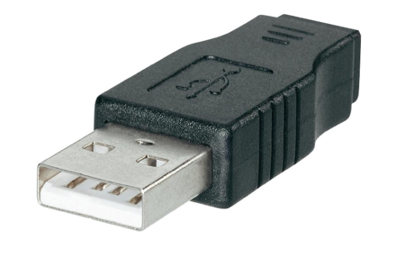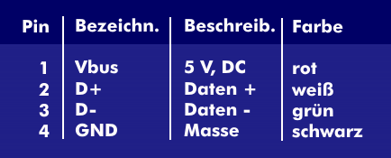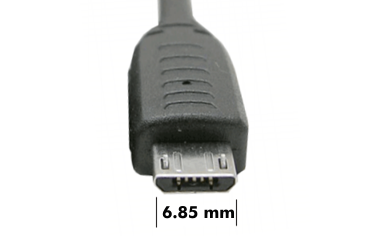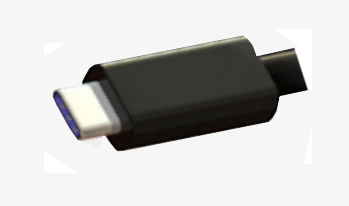USB connector
For the USB interface, there is a wide variety of USB connectors that meet the requirements of the different versions, their data rates and space requirements. Since the introduction of the USB interface, there have been the classic connector types A and B, which were later developed as mini and micro versions. It was not until USB 3.1 and the associated high data rates that the USB 3.0 Type C connector was developed, which will also be used in the next USB versions in the coming years as a universal flat connector.
The different USB connector variants
The USB plug type A is a flat, twist- proof plug with four contacts. Two contacts (1 and 4) are used for power supply, the other two are used for data transfer (D+ and D-). All wires connected to the contacts are color-coded.
The type A connector is the host-side USB connector, periphery-side it is the type B USB connector. Type B is almost square and has rounded edges. The B connector has two contacts on the top and two on the bottom. Both connectors, the A and B type as well as their mini and micro versions, are used in USB 1.x and USB 2.0.
The mini-USB is a scaled-down USB connector, also known as a mini-B. It has five contacts, four of which are the same as the standard USB connector, and the fifth contact is ground and connected to the shield. The mini USB plug is a flat USB plug with a width of 6.9 mm. The type A connector, on the other hand, has a width of 12 mm.
The Micro-USB plug is a miniature plug for mobile devices such as MP3 players, cell phones, smartphones, digital cameras, etc. The Micro-USB plug is available in several versions, which differ in the plug shape. In the B version, the lower edges of the plug are beveled in a trapezoidal shape. The mentioned plug variants are for USB 1.x and USB 2.0 versions and are ideal for small devices such as MP3 players, cell phones, digital cameras, etc. The Micro USB plug is also used as a plug for chargers, putting a stop to the manufacturer-specific variety of charger plugs.
As for the USB 3.0 version, the 3.0 interface has five more wires and a special USB 3.0 cable. The standard USB Type A connector has been fitted with an additional contact strip, the Type B has had a mini B flanged onto it and the Micro USB connector has been extended with a second connector on the side.
The flat Type A connector has the same design, but it has an additional contact layer with five contacts next to each other, which are located behind the contact layer of the 2.0 connector. Two contacts each are used for the transmission of the differential signalsSuperSpeed Transmit (SSTx) and SuperSpeed Receive (SSRx). In between, there is a ground line as the fifth wire for shielding.
With the type B connector, the difference is clearly visible in the attachment above the USB 2.0 type B connector. The five additional contacts for USB 3.0 are located in this attachment. The plug concept is realized in such a way that classic USB cables with A and B plugs can still be used, but not with the data rates of USB 3.0.
And with the Micro USB 3.0 connector, you can see the plug attached to the side.
USB-C for USB 3.1
The USB-C interface has been developed by the USB Implementers Forum( USB-IF) for USB 3.1 since 2013 and supports data rates of 10 Gbit/s. Another difference to the known USB connectors are the higher voltages and currents transmitted by the Type-C connector for power supply, USB Power Delivery( USB-PD). They are 20 V and 5 A, corresponding to the highest Profile 5 with 100 W. Type-C plugs have two contact strips with 12 contacts each. Two springs on the side are used to secure the plug. They ensure a secure hold. The specifications stipulate 10,000 mating operations.
The Type-C connector is a compact USB plug with dimensions of 8.3 x 2.5 mm that can be used equally in laptops, smartphones, tablets and other mobile devices. Type-C connection cables have Type-C plugs on both ends.






